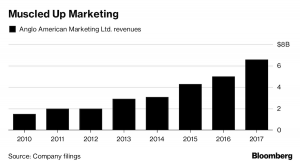Anglo American Plc has quietly become a commodities trader.
In just five years, the century-old miner assembled marketing operations that now sell more metals than the company produces. Yet the trading business gets barely a mention at presentations by Anglo executives or in analyst reports, taking a back seat to mines that produce everything from copper and platinum to diamonds.
Anglo’s move into trading goes against a long-standing industry maxim: miners don’t trade. For much of the last two decades, investors wanted producers’ shares to track soaring metals prices and resisted anything that might get in the way. The orthodoxy was challenged when Glencore Plc broke into the big leagues of global mining with the acquisition of Xstrata in 2013, roughly when Anglo started building its trading unit.
Trading its own production allows Anglo to save money and get insight into metals markets, said Peter Whitcutt, the company’s head of marketing. It’s built a network that stretches from the mine gates of platinum in South Africa to copper high in the Andean mountains, funneling almost everything it digs up through a central hub in Singapore.

From there, it made sense to buy and sell minerals produced by others as well, and the company could even go a step further and start taking financial bets, in addition to trading the physical metal, he said.
“We have great customer relationships and we can move product around the world. Why wouldn’t we put other people’s material through our system?” Whitcutt said in an interview. “As we become more comfortable with it institutionally, it may be that the best way we can express a view is financially rather than physically.”
The Numbers:
Last year, $6.6 billion of commodities flowed through Anglo’s main marketing...

